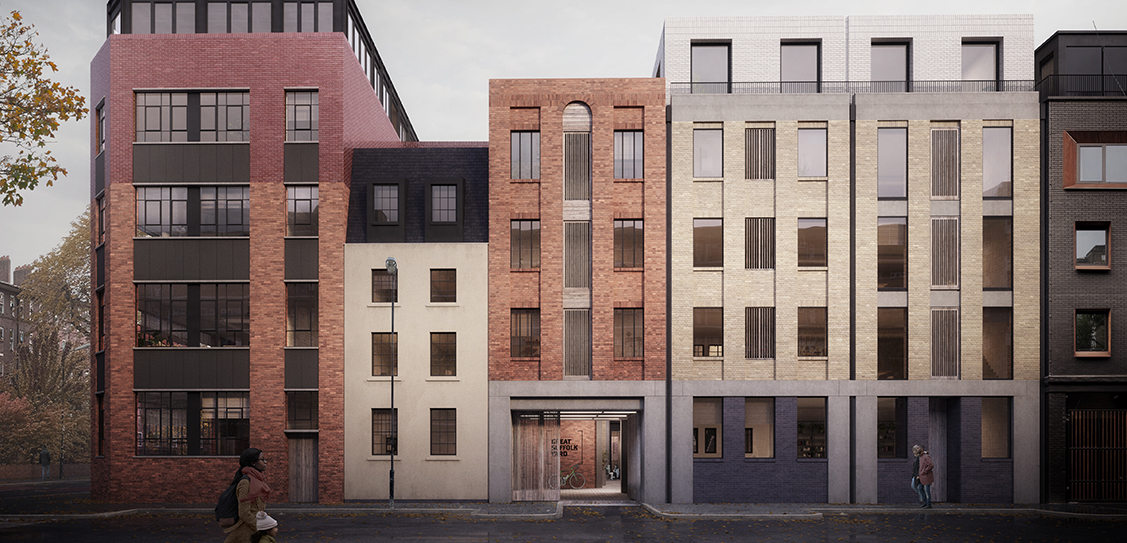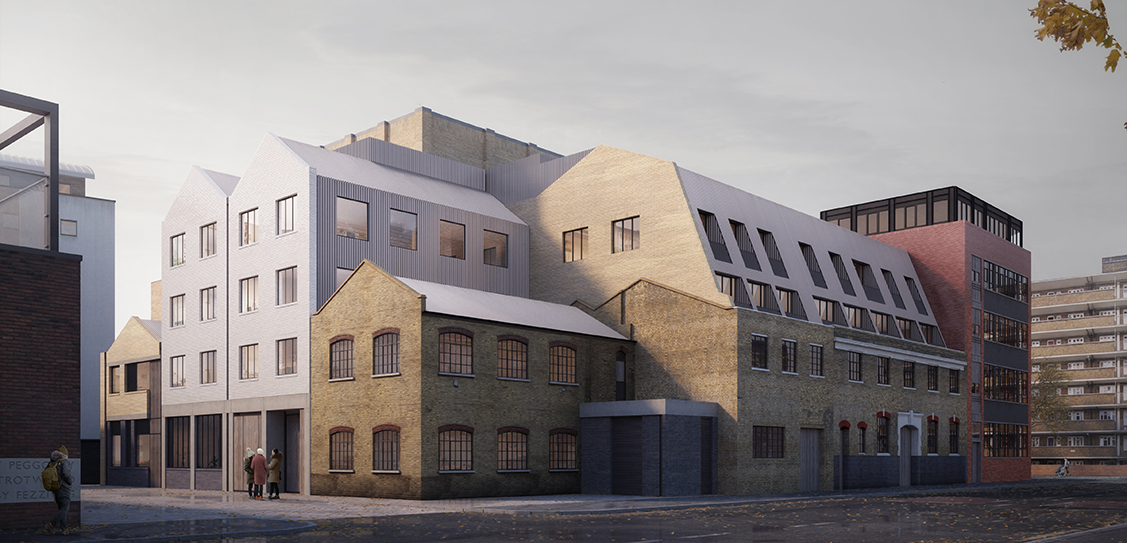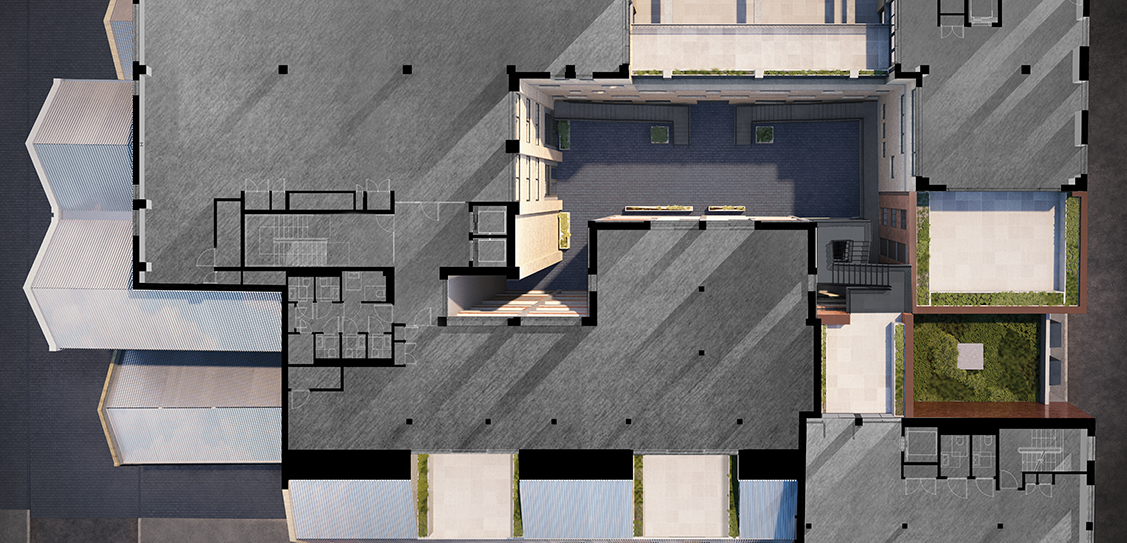Great Suffolk Yard is a commercial development in the Liberty of the Mint Conservation Area in Borough.
The scheme aims to repurpose the block as a family of buildings to preserve its eclectic character and historic patina.
TDO’s design retains, refurbishes and extends three of the buildings on the site, complementing them with four new buildings around a central yard to complete the city block.
The client, developer Tailored Living Solutions (TLS), is based in the area and works predominantly in Southwark and the surrounding boroughs.
The site is made up of industrial buildings from different periods - the earliest dating from 1850 - which have been altered over the years.
It’s a privilege to be working on a piece of the city in our neighbourhood, a stone’s throw from our studio. There is complexity but also a coherence to the site that we knew needed to be understood, respected and worked with.
We have chosen robust materials echoing material choices that have successfully stood the test of time on the site over the past 150 years, and we’ve designed a flexible plan to accommodate either a single tenant or multiple tenants, ensuring adaptability and longevity in the building’s future use.
Built around a central yard, the eclectic existing buildings - ranging between two and three storeys - reflect the industrial history of the wider area: tall warehouses assembled closely around a canyon-like shared yard.
TDO is based in the locality, and conducted extensive archive, library and physical site research and worked closely with Southwark’s planning officers over two pre-applications to develop a scheme which is embedded in the neighbourhood.
The site has three street frontages: Great Suffolk Street, Toulmin Street and Pickwick Street, with long views along Great Suffolk Street.
The surrounding context is a mix of post-war yellow brick residential blocks, a parade of shops and cafés, and the three-storey red brick Libertine pub.
The neighbouring Charles Dickens Primary School includes a recent extension deploying red bricks and black metalwork to complement the main Victorian school.
The client brief required a contemporary commercial development which offered the flexibility to be let either as a single building or to multiple tenants, with a 1:6 or 1:8 capacity.
This presented a tension between the requirement of the plan - to provide connected open plan floor space - and the elevations and character of the site, which called for conserving a family of distinct buildings.
The site is characterised by a mixture of brick types and tones, stone details, concrete banding, framing and lintels, timber doors, metal windows, corrugated metal roofing and tiled roofs.
TDO’s strategy has been to divide the plot into key massing elements, rebuilding it holistically through a series of new buildings, rooftop extensions and roof terraces.
The buildings include:
- The Sea Building (formerly occupied by a fish merchant) - a three-storey corner building which will be extended by two storeys, raising it to the same height as Signal Works,
- A previously consented scheme further along Great Suffolk Street. The extension is differentiated by a glazed red brick, in contrast to the plain brick below, to delineate new from old. A black metal, set-back top-level completes the corner of the plot.
- The Town House on Great Suffolk Street - the last of a 19th-century terrace that stood on the site, which will be retained and gain a mansard roof extension.
- The Carriageway Building on Great Suffolk Street - a 20th-century addition contributing little to the site, which will be replaced by a new building two storeys higher, that draws on the industrial language of the area and creates a purposeful entrance from the street to the central courtyard.
- The Engineering Building on Great Suffolk Street Street - two-storey industrial engineering works building heavily altered in the 1950s and most recently used as offices – which will be replaced by a more efficient BREEAM Excellent structure that draws on the history of the area and its building types. The new building will range from three to six storeys and includes an outdoor terrace linking to the front-facing Great Suffolk Street.
- The Works - a fine historic workshop building with corrugated metal roof, will gain a new corrugated metal mansard roof which will provide three new storeys set behind recessed terraces facing Toulmin Street.
- Pickwick Corner - a good example of the area’s warehouse typology, will be retained. Its roof will be replaced with a new folded metal roof that runs up and over the adjacent Pickwick Buildings. A forecourt will provide cycle and car parking.
- Pickwick Building on Pickwick Street - an existing, low-quality warehouse, will be completely rebuilt as a building of three bays ranging from two to four storeys. The new Pickwick Buildings are designed as a set with Pickwick Corner, rising in the middle two buildings to four storeys.
The existing central yard space at the heart of the scheme can be accessed at both ends of the site, from Great Suffolk Street and Pickwick Street.
Currently under-utilised as a car park, it is a valuable amenity bringing in daylight and natural ventilation to the workspaces.
It will be completely transformed with a network of exterior metal walkways - redolent of Shad Thames’ walkways - scaling the perimeter buildings and opening up routes into the yard from all levels of the buildings, animating the yard and creating a sense of community across the site.
Served by a ground floor café, the yard will be a dynamic communal space at the hub of the development, complementing the new roof terraces which will provide spaces for retreat and reflection.
Internally, the original buildings will be stripped back to their core, exposing the brick walls and increasing daylight levels.
Emulating a raw, industrial aesthetic, services will be exposed throughout.
New additions will be characterised by fair-faced blockwork and self-finished materials, drawing a clear distinction between new and old.
Floorplates have been designed to create a clear sequence of spaces across the site so that the buildings can be occupied by a single tenant or multiple tenants.
Wayfinding is identified by timber doors and gates throughout to signify entry moments from the surrounding streets.
The dark stained timber finish has also been used throughout as a unifying, legible element.
Reuse of the existing buildings and carefully composed new additions also dramatically reduces the amount of waste that would have been generated and takes advantage of the significant embodied energy on the site.


